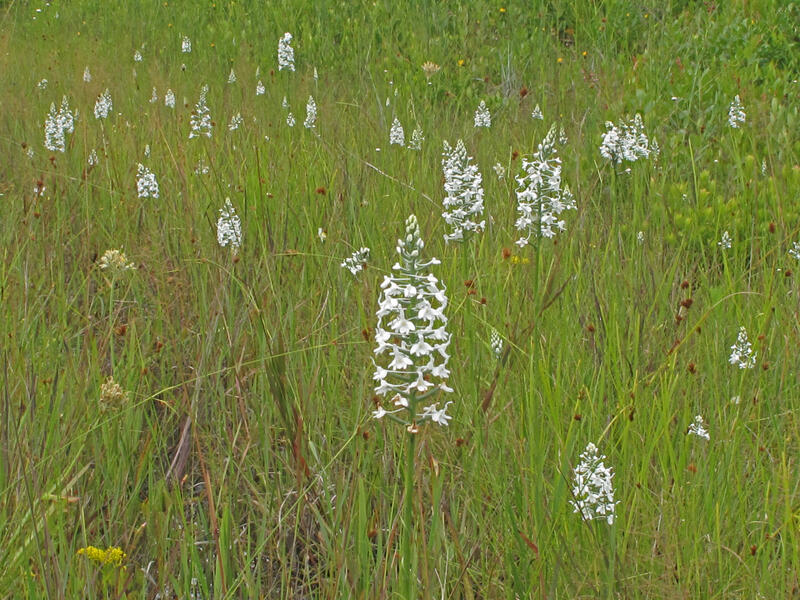







Loading profile. Please wait . . .
Platanthera nivea (Nutt.) Luer
Snowy Orchid




Federal Protection: No US federal protection
State Protection: No Georgia state protection
Global Rank: G3G4
State Rank: S2S3
Element Locations Tracked in Biotics: Yes
SWAP 2015 Species of Greatest Conservation Need (SGCN): No
SWAP 2025 Species of Greatest Conservation Need (SGCN): Yes
2025 SGCN Priority Tier: High Conservation Concern
Element Occurrences (EOs) in Georgia: 19
Habitat Summary for element in Georgia: Wet savannas, pitcherplant bogs
Perennial herb with green, hairless, erect stems 0.5 - 3 feet (17 - 90 cm) tall. Its leaves are 1-3 in number, 1-12 inches long and up to 0.8 inch wide (3-31 cm long and 0.3-2 cm wide), alternate, basal, narrowly lance-shaped, hairless, usually folded lengthwise, often withered away by flowering time. The flowers are pure snowy white and held in a large, dense cluster at the top of the stem; they are not resupinate. The three sepals are oval-oblong, spreading, with one pointing down. The two lateral petals are oblong and downcurved. The lip petal is uppermost, oblong, not fringed; the spur, a backward extension of the lip petal, is 0.4-0.7 inch (1-1.8 cm) long and tubular. The fruit is a slender capsule, up to 0.6 inch (0.4-1.2 cm) long, containing many tiny seeds.
Small White Fringed Orchid (Platanthera blephariglottis, Special Concern) occurs in wet seeps in Georgia’s Coastal Plain. For more information, see: https://www.georgiabiodiversity.a2hosted.com/portal/profile?group=plants&es_id=17377
Large White Fringed Orchid (Platanthera conspicua, Special Concern) occurs in bogs, seeps, wet savannas, and wet roadsides in Georgia’s Coastal Plain. For more information, see: https://www.georgiabiodiversity.a2hosted.com/portal/profile?group=plants&es_id=18565
Monkeyface Orchid (Platanthera integrilabia, US and Georgia Threatened) occurs in Red Maple-Black Gum swamps and peaty seeps and along streambanks in north Georgia. For more information, see: https://www.georgiabiodiversity.a2hosted.com/portal/profile?group=plants&es_id=19469on this website.
There are 10 rare species of Platanthera in Georgia. For information on each of these, see: https://www.georgiabiodiversity.org/portal/element_lists?group=plant
Moist to wet pine flatwoods, pine savannas, bogs, and cypress swamps.
Platanthera nivea (synonym Gymnadeniopsis nivea) is a perennial herb that reproduces by seed.
Its flowers are pollinated by butterflies and skippers. As an insect probes for nectar in the elongated spur, sticky polllen packets attach to its proboscis and are brushed off onto the stigmas of flowers that are subsequently visited.
Snowy Orchid may be very common in a particular area one year and then be rare or totally absent from the same area for a number of years.
| Threat 1 | Threat 2 | Threat 3 | |
|---|---|---|---|
| General Threat | Transportation & Service Corridors | Residential & commercial development | Natural system modifications |
| Specific Threat | None | None | None |
Argue, C.L. 2012. The pollination biology of North American orchids: Volume 1, North of Florida and Mexico, Part II: subfamily Orchidoideae (part one), Chapter 8, Platanthera. Springer Science+Business Media, LLC. https://link.springer.com/content/pdf/10.1007%2F978-1-4614-0592-4.pdf
Diamond, A. Platanthera nivea species account. Alabama Plant Atlas, University of West Alabama, Livingston, Alabama. http://floraofalabama.org/Plant.aspx?id=4603
Drake, J. 2013. Fringed orchids of the southeastern United States: a guide to the genus Platanthera. Breath o’ Spring, Inc. P.O. Box 2957, Suwanee, Georgia 30024.
North American Orchid Conservation Center. 2011-2020. Platanthera nivea (Nutt) Luer, Snowy Orchid. Smithsonian Environmental Research Center, Edgewater, MD. https://goorchids.northamericanorchidcenter.org/species/platanthera/nivea/